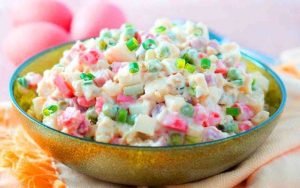
When people think about salad, they would usually associate it with healthy diet or a bowl of fruits and vegetables with no carbohydrate or protein in it. But, did you know, the definition of salad is actually a dish of mixed small pieces of food. So, by saying food, salad can contain all sorts of edible items. Garden salad is the most common type of salad in the whole world that has leafy greens as the base like lettuce, kale, spinach, arugula, and more. Because of its popularity, garden salad is what people would take as ‘salad’ in general. This dish can be served as an appetizer, a side dish, a main course – if it contains high-protein food, and a dessert.
Almost every country in the world has its own signature salad with a unique history behind each of them. There is fattoush, a salad from Syria that contains toasted or fried khubz – Arabic bread, mixed greens, radishes and tomatoes. There is also horiatiki salad from Greece that puts slices of tomatoes, cucumbers, onion, bell peppers, olives, with feta cheese on top and seasoned with salt and oregano. A dish of salad doesn’t come ‘naked’ because it usually uses a sauce called ‘dressing’ that could be based on oil and vinegar or dairy product like yogurt and kefir.
Russia also has its own version of salad called the Olivier salad. Like horiatiki that people commonly call as Greek salad, Olivier is known as the Russian potato salad. There are some awesome facts you can learn from this traditional dish. Let us see 11 of them:
1. Olivier salad was invented by a Belgian cook, not a Russian. It was in 1860s when Lucien Olivier, a Belgian chef who worked at the Hermitage – one of Moscow’s most popular restaurants at that time, found the original recipe of the salad, hence the name of the dish.
2. The exact authentic recipe remains a mystery until today. It is believed that the first Olivier salad included smoked duck, caviar, lettuce, crayfish tails, capers, grouse, and veal tongue. The original dressing was something like mayonnaise, possibly made from mustard, French wine vinegar, and olive oil.
3. The mysterious recipe of the original Olivier salad was once stolen by one of Lucien Olivier’s sous-chefs named Ivan Ivanov. He got the chance when Olivier had to leave his station in a sudden for an emergency call. Ivanov had enough time to get into Olivier’s private kitchen and observed the ingredients needed to make the salad with. He then left his job at the Hermitage and attempted to make the copy of the salad for Moskva, a smaller restaurant in Moscow. He named it capital salad or stolichny. However, it couldn’t surpass Olivier salad’s taste because some ingredients were missing from the dressing.
4. The authentic Olivier salad is one of the most expensive dishes in Russia because some of the ingredients are seasonal and rare. However, since the salad is always on the high-end restaurants’ menu, seasonal ingredients have to be replaced with other food when the weather doesn’t permit.
5. Russians had to substitute the Olivier salad’s ingredients in the post-revolutionary Russia: grouse by chicken or sausage, crayfish by hard-boiled eggs, and olives by green peas. In 1894, the first printed recipe of the salad mentioned diced boiled potatoes as one of the main ingredients.
6. Interestingly, the modern version of the Oivier salad is actually closer to Ivan Ivanov’s stolichny rather than the authentic recipe. It includes boiled potatoes, dill pickles, peas, eggs, carrots, and boiled chicken or beef or bologna with mayonnaise dressing. This version is also the more popular one across Russia with more acceptable taste.
7. The modern version of the Olivier salad was one of the compulsory dishes in any Soviet’s holiday dinner, especially the New Year’s celebration. It was said to be on the same level as Soviet Champagne and mandarin oranges.
8. In December 2012, in Orenburg – by the Ural River, the biggest Olivier salad was prepared. It weighed 1,841 kilograms.
9. Many versions of the Oliver salad can be found around the globe. In Romania, it is called beef salad and considered as a traditional dish. The unique ingredients are root vegetables and traditional Romanian mixed pickles. The Polish version of the salad is always vegetarian, which means no meats included. In Spain, the dish is named ensaladilla rusa or little Russian salad and considered as a tapa or appetizer in many bars. In Pakistan and India, Olivier salad includes pineapples, peas, and apples – served as a side dish. In Mongolia, the salad always appears during the festive season.
10. The original recipe of the Olivier salad included no potatoes, but now the dish is widely known as Russian potato salad. There is definitely something to look into in that fact. This is possible because Ivan Ivanov sold the recipe to the publishing houses and his version included potatoes. You can make note of the importance of publicity to popularize something from this case.
11. Olivier salad is versatile, as long as it includes potatoes and dressed in mayonnaise. One can make it healthy, less healthy, expensive, cheap, exclusive, economical, and so on depends on the other ingredients beside the two above.
With all the 11 awesome facts about the Russian Olivier salad have been mentioned above, it would be safe to say that you – at least once – have ever tasted a version of it. With all the flexibilities it offers, you can even make your own Olivier salad at home. It is a great dish to be served to your guests for dinner. But, if you ever want to try the closest one to the original recipe, you can try and find it in one of Russia’s high-end restaurants.
